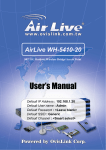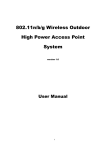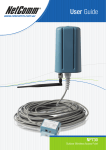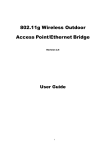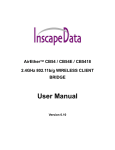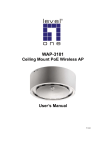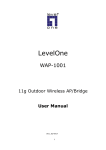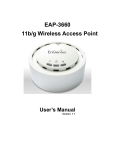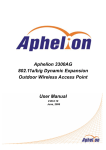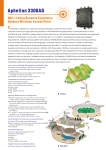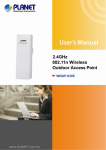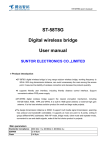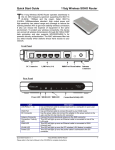Download Manual - Korenix
Transcript
Korenix JetWave 2420 IEEE 802.11b/g Wireless Outdoor PoE AP User Manual Version 1.0, Aug., 2009 www.korenix.com 1 FCC Notice NOTE: This equipment has been tested and found to comply with the limits for a Class B digital device, pursuant to part 15 of the FCC Rules. These limits are designed to provide reasonable protection against harmful interference in a residential installation. This equipment generates, uses and can radiate radio frequency energy and, if not installed and used in accordance with the instructions, may cause harmful interference to radio communications. However, there is no guarantee that interference will not occur in a particular installation. If this equipment does cause harmful interference to radio or television reception, which can be determined by turning the equipment off and on, the user is encouraged to try to correct the interference by one or more of the following measures: —Reorient or relocate the receiving antenna. —Increase the separation between the equipment and receiver. —Connect the equipment into an outlet on a circuit different from that to which the receiver is connected. —Consult the dealer or an experienced radio/ TV technician for help. Changes or modifications not expressly approved by the party responsible for compliance could void the user’s authority to operate the equipment. The antenna(s) used for this transmitter must not be co-located or operating in conjunction with any other antenna or transmitter. The manufacture is not responsible for any radio or TV interference caused by unauthorized modifications to this equipment. Such modifications could void the user’s authority to operate the equipment. 2 The Wireless Technology Standard The Wireless Access Point utilizes the 802.11b and the 802.11g standards. The IEEE 802.11g standard is an extension of the 802.11b standard. It increases the data rate up to 54 Mbps (108Mbps in Super G mode) within the 2.4GHz band, utilizing OFDM technology. This means that in most environments, within the specified range of this device, you will be able to transfer large files quickly or even watch a movie in MPEG format you’re your network without noticeable delays. This technology works by transmitting high-speed digital data over a radio wave utilizing OFDM (Orthogonal Frequency Division Multiplexing) technology. OFDM works by splitting the radio signal into multiple smaller sub-signals that are then transmitted simultaneously at different frequencies to the receiver. OFDM reduces the amount of cross talk (interference) in signal transmissions. The AP will automatically sense the best possible connection speed to ensure the greatest speed and range possible. 802.11g offers the most advanced network security features available today, including: WPA, WPA2, TKIP, AES and Pre-Shared Key mode. U Planning Your Wireless Network Network Topology A wireless network is a group of computers, each equipped with one wireless adapter. Computers in a wireless network must be configured to share the same radio channel. Several PCs equipped with wireless cards or adapters can communicate with one another to form an ad-hoc network. The wireless adapters also provide users access to a wired network when using an access point or wireless router. An integrated wireless and wired network is called an infrastructure network. Each wireless PC in an infrastructure network can talk to any computer in a wired network infrastructure via the access point or wireless router. An infrastructure configuration extends the accessibility of a wireless PC to a wired network, and may double the effective wireless transmission range for two wireless adapter PCs. Since an access point is able to forward data within a network, the effective transmission range in an infrastructure network may be doubled. 3 Roaming Infrastructure mode also supports roaming capabilities for mobile users. Roaming means that you can move your wireless PC within your network and the access points will pick up the wireless PC's signal, providing that they both share the same channel and SSID. Before enabling you consider roaming, choose a feasible radio channel and optimum access point position. Proper access point positioning combined with a clear radio signal will greatly enhance performance. Network Layout The AP Access Point has been designed for use with 802.11g and 802.11b products. With 802.11g products communicating with the 802.11b standard, products using these standards can communicate with each other. The Access point is compatible with 802.11g and 802.11b adapters, such at the PC Cards for your laptop computers, PCI Card for your desktop PC, and USB Adapters for when you want to enjoy USB connectivity. These wireless products can also communicate with a 802.11g or 802.11b wireless Print Server. When you wish to connect your wired network with your wireless network, the Access Point’s network port can be used to connect to any of switches or routers. Installation Considerations The AP lets you access your network, using a wireless connection, from virtually anywhere within its operating range. Keep in mind, however, that the number, thickness and location of walls, ceilings, or other objects that the wireless signals must pass through, may limit the range. Typical ranges vary depending on the types of materials and background RF (radio frequency) noise in your home or business. The key to maximizing wireless range is to follow these basic guidelines: Keep your product away (at least 3-6 feet or 1-2 meters) from electrical devices or appliances that generate RF noise. Keep the number of walls and ceilings between the AP and other network devices to a minimum - each wall or ceiling can reduce your AP’s range from 3-90 feet (1-30 meters.) Position your devices so that the number of walls or ceilings is minimized. Be aware of the direct line between network devices. A wall that is 1.5 feet thick(.5 meters), at a 45-degree angle appears to be almost 3 feet (1 meter) thick. At a 2-degree angle it looks over 42 feet (14 meters) thick! 4 Position devices so that the signal will travel straight through a wall or ceiling (instead of at an angle) for better reception. Building materials can impede the wireless signal - a solid metal door or aluminum studs may have a negative effect on range. Try to position wireless devices and computers with wireless adapters so that the signal passes through drywall or open doorways and not other materials. Applications The wireless LAN products are easy to install and highly efficient. The following list describes some of the many applications made possible through the power and flexibility of wireless LANs: Difficult-to-wire environments There are many situations where wires cannot be laid easily. Historic buildings, older buildings, open areas and across busy streets make the installation of LANs either impossible or very expensive. Temporary workgroups Consider situations in parks, athletic arenas, exhibition centers, disaster-recovery, temporary offices and construction sites where one wants a temporary WLAN established and removed. The ability to access real-time information Doctors/nurses, point-of-sale employees, and warehouse workers can access real-time information while dealing with patients, serving customers and processing information. Frequently changed environments Show rooms, meeting rooms, retail stores, and manufacturing sites where frequently rearrange the workplace. Small Office and Home Office (SOHO) networks SOHO users need a cost-effective, easy and quick installation of a small network. Wireless extensions to Ethernet networks Network managers in dynamic environments can minimize the overhead caused by moves, extensions to networks, and other changes with wireless LANs. Wired LAN backup Network managers implement wireless LANs to provide backup for mission-critical applications running on wired networks. 5 Network Topology – AP Mode and Client Mode 6 Network Topology – Repeater Mode Network Topology – Wireless Bridge (WDS) Point to Multi-Point Mode 7 Installation Diagram 8 APE Installation Diagram Attention: The cable distance between the Router and PC/hub/Switch should not exceed 100 meters. Make sure the wiring is correct. In 10Mbps operation, Category 3/4/5 cable can be used for connection. To reliably operate your network at 100Mbps, you must use Category 5 cable, or better Data Grade. 9 AP Configuration Using Locator While entering the Locator utility, the Locator will automatically search the AP available on the same network. Locator will show the Device Name, Device Type, IP Address, Ethernet MAC Address and Firmware Version in first page. Before start using Locator, make sure you disable personal firewall installed in you PC. (Ex. Windows XP personal firewall) If you have 2 Fast Ethernet Adapter or more, you can choose enable one Fast Ethernet Adapter for enter with Locator utility. AP Configuration Using Web User Interface Before Setup… Verify the IP address setting You need to configure your PC’s network settings to obtain an IP address. Computer use IP addresses to communicate with each other across a network, such as the Internet. 1. 2. 3. From the taskbar, click the Start button, select Settings > Control Panel. From there, double-click the Network connections icon. Right click the Local Area Connection icon Properties; select the TCP/IP line for the applicable Ethernet adapter. Then, click the Properties button. Click the IP Address tab page, select USE the following IP address, type 192.168.254.254 (but, 192.168.x.x for the device use) in the IP Address field and 255.255.0.0 in the Subnet Mask field, then click OK button. Start Setup by Browser... 1. After getting the correct connection, start the web browser (make sure you disable the proxy) and type 192.168.x.x (x is outdoor unit IP Address) in the Address field. Press Enter. 10 2. 3. Enter the factory default User name and Password fields: User Name: Admin Password: (leave blank) then click OK button. You will enter the Utility homepage. Start Setup by Locator... 1. You just need to click on the “Web” icon in Locator main page. The Locator will launch a default browser for you and lead you into web UI directly 11 Wireless Configuration - AP Mode System Status – The first page appears in main page will show “System Status -> System Summary” automatically, you can find detail system configuration in this page including System Information – This will display system name and both Ethernet MAC address and Wireless MAC address. Current country setting and Current time. firmware version and Management VLAN ID Current IP Settings – This section show current IP address setting including IP address, Subnet Mask, Default Gateway and DHCP status. Current Wireless Settings – This area show current wireless setting including operation mode, wireless mode, Channel/Frequency, profile isolation, profile settings(SSID/Security/VID),Spanning Tree Protocol and Distance.. 12 The first page appears in main page will show “System Status -> Wireless Station List” automatically, this page can help user identify current devices who already associated to the AP. The MAC addresses and signal strength for each client is displayed. Click on the Refresh button to refresh the client list 13 Event Log – Click on the Event Log link under the Status drop-down menu. The device automatically logs (records) events of possible interest in its internal memory. If there is not enough internal memory for all events, logs of older events are deleted, but logs of the latest events are retained. System Configuration – Now you can start to configure the system. In System Properties page, you can config Device Name – You may assign any name to the Access Point. Memorable, Unique names are helpful especially if you are employing multiple access points on the same network. The device name needs to be less than 32 characters. After verify the name you input and click “Apply” to save the setting. Country/Region – Here you can set the AP to follow different country and region regulation. The AP can support Operation Mode - The default operation mode is Access Point, this 14 connects your wireless PCs and devices to a wired network. In most cases, no change is necessary. You can switch operation mode to Wireless Client or Repeater or Bridge mode depends on your application. Wireless Client mode can allow AP act as a client within its range. Your Ethernet devices behind the AP can connect to remote AP. Repeater is able to talk with one remote access point within its range and retransmit its signal. Choose repeater mode if you want to extend the range of your original AP. Wireless Bridge (WDS) can allow Bridge point to point or point to multi-point network architecture, In order to establish the wireless link between bridge radios, the MAC address of remotes bridge(s) need to be registered in the address table. Type the MAC address with format xx:xx:xx:xx:xx:xx (x is the hexadecimal digit) and use “Add” and “Delete” button to edit the address table. A Master Bridge Radio may accommodate up to 16 remote MAC addresses. 15 IP Settings – IP Setting page can configure system IP address. Default IP address is 192.168.1.1 and Subnet Mask is 255.255.255.0. You can manually input IP address setting or get an IP from a DHCP server. IP Network Setting – Here you can choose to get IP from a DHCP server or specify IP address manually. Choose to obtain an IP address from DHCP server if your environment or ISP provide DHCP server. Otherwise, you can manually setup IP address. IP Address – The IP address need to be unique to your network. We would like to recommend you stay with default IP address 192.168.x.x. This is private address and should work well with your original environment. IP Subnet Mask – The Subnet Mask must be the same as that set on your Ethernet network. Default Gateway – If you have assigned a static IP address to the Access Point, then enter the IP address of your network’s Gateway, such as a router, in the Gateway field. If your network does not have a Gateway, then leave this field blank. 16 Spanning Tree Settings – Click on the Spanning Tree link under the System Configuration drop-down menu Spanning-Tree Protocol is a link management protocol that provides path redundancy while preventing undesirable loops in the network. Spanning Tree Status: Choose to enable or disable the spanning tree feature. Bridge Hello Time: Specify the number of seconds for the hello time. Bridge Max Age: Specify the number of seconds for the max age. Bridge Forward Delay: Specify the number of seconds for the bridge forward delay. Priority: Specify the number of seconds for the priority. Click on the Apply button to save the changes. 17 In Wireless Setup page, each option is described below Wireless Network At Wireless Network page allows you to configure the “Wireless Mode”, “Channel/Frequency”, “SSID” and “Security”. Wireless Mode – Default setting is “802.11g Only (2.4GHz/54Mbps)”. This will support all 802.11g clients connect to the AP. You can choose “802.11b (2.4GHz/11Mbps)” in wireless mode column if your environment only have 802.11b clients. If you are not sure about which clients will be accessing the wireless networks, it is recommended that you select “802.11b/g Mixed (2.4GHz/54Mbps)” for the best performance. Channel / Frequency –The channels available are based on the country’s regulation and select the appropriate channel from the list provided to correspond with your network settings. Current Profiles – You may configure up to four different wireless profiles. Click on the Edit button to modify the profile and place a check in the Enable box to activate the profile Profile (SSID) Isolation – Stations connected to different profiles cannot access each other. Choose from “No Isolation” (Full access), or to Isolate all profiles (SSIDs) from each other, check use VLAN (802.1Q) standard SSID – The SSID is the unique name shared among all points in a wireless network. The SSID must be identical for all points in the wireless network. It is case-sensitive and must not exceed 32 alphanumeric characters, which may be any keyboard character. Make sure this setting is the same for all points in your wireless network. For added security, you should change the SSID from the default name Generic1, to a unique name 18 VLAN ID – If you have enabled VLAN tagging on your network, specify the VLAN tag ID 1 to 4095. You can assign an SSID to a VLAN. Client devices using the SSID are grouped in that VLAN Suppressed SSID – This option can hide the SSID not available from site survey tool. Enable this function only if you do not want the Access Point to be found by others. Stations Separation – Default setting is “Disable”. This option can disallow the client devices connected to this AP could not access each other. Security Mode: By default, the security is disabled. Refer to the next section to configure the security features such as WEP, WPA, WPA-PSK, WPA2, WPA2-PSK and WPA-Mixed Click on the Apply button to save the changes. 19 Wireless Security The wireless security settings configure the security of your wireless network. There are three wireless security mode options supported by the Access Point: WEP, WPA-PSK, WPA and WPA2. (WPA stands for Wi-Fi Protected Access, which is a security standard stronger than WEP encryption. WEP stands for Wired Equivalent Privacy.) In Wireless Security page, you can configure the AP to work with Disabled is no Security, WEP, WPA-PSK, WPA and WPA2 security mode. Once you setup the AP to work in security mode, all wireless stations will also need to have corresponding settings. System default setting is “No Security”. WEP is a basic encryption method, which is not as secure as WPA. To use WEP, you will need to select a default transmit key and a level of WEP encryption, Authentication Type: Select an authentication method. Options available are Open Key, Shared Key or Auto. An open system allows any client to authenticate as long as it conforms to any MAC address filter policies that may have been set. All authentication packets are transmitted without encryption. Shared Key sends an unencrypted challenge text string to any device attempting to communicate with the Access Point. The device requesting authentication encrypts the challenge text and sends it back to the Access Point. If the challenge text is encrypted correctly, the Access Point allows the requesting device to authenticate. It is recommended to select Auto if you are not sure which authentication type is used. Input Type: Select Hex or ASCII from the drop-down list Key Length: Select a key format from the drop-down list. 40/64bit-hex keys require 10 characters or ASCII keys require 5 characters, where as 104/128-bit-hex keys require 26 characters or ASCII keys require 13 characters, as 128/152-bit-hex keys require 32 characters or ASCII keys require 16 characters. A hex key is defined as a number between 0 through 9 and letter between A through F. Default Key: You may use up to four different keys for four different networks. Select the current key that will be used. 20 Key table – You can input 4 different WEP encryption keys into the table and by choosing the radio button to decide which one is valid now. The AP supports 64, 128 and 152bit key length. The longer key we choose usually means the encryption is stronger. After all changes are made, be sure to click on “Save” to make sure all changes are saved into system. WPA-PSK stands for Wi-Fi Protected Access – Pre-Shared Key. WPA-PSK is design for home users who do not have RADIUS server in their network environment. WPA can provide better security level than WEP without difficult setting procedure. PassPhrase - Enter a WPA Shared Key of 8-63 characters. The Shared Key should be also applying the clients work in the same wireless network. Encryption - WPA gives you two encryption methods, TKIP and AES, 21 with dynamic encryption keys. Select the type of algorithm, TKIP or AES. Group Key Update Interval - Enter a number of seconds which instructs the Access point how often it should change the encryption keys. Usually the security level will be higher if you set the period shorter to change encryption keys more often. Default value is 3600 seconds, set 0 in Group Key Update Interval to disable key renewal. Remember to click on “Save” to make sure all changes are made before leaving this page. WPA option features WPA used in coordination with a RADIUS server. (This should only be used when a RADIUS server is connected to the Access Point.) RADIUS Server – Here enter the IP address of your RADIUS server. RADIUS Port – Port number for RADIUS service, default value is 1812 22 RADIUS Secret – RADIUS secret is the key shared between Access Point and RADIUS server. Encryption – WPA gives you two encryption methods, TKIP and AES, with dynamic encryption keys. Select the type of algorithm, TKIP or AES. Group Key Update Interval – This column indicate how often should the Access Point change the encryption key. Default value is 3600 seconds, set 0 in Group Key Update Interval to disable key renewal. 23 Wireless MAC Filter – On this page you can filter the MAC address by allowing or blocking access the network. ACL (Access Control) Mode: You may choose to Disable, Allow Listed, or Deny Listed MAC addresses from associating with the network. By selecting Allow MAC in the List, only the address listed in the table will have access to the network; all other clients will be blocked. On the other hand, selected Deny MAC in the List, only the listed MAC addresses will be blocked from accessing the network; all other clients will have access to the network. MAC Address: Enter the MAC address. This table lists the blocked or allowed MAC addresses; you may delete selected MAC address or delete all the addresses from the table by clicking on the Delete button. Click on the Apply button to save the changes. 24 WDS Link Settings – On this page you can configure the AP WDS (Wireless Distribution System) which allows the Access Point to function as a repeater, up to 8 links. WDS MAC Address: Specify the Wireless MAC address of the Access Points that will join the WDS network and then select Enable or Disable from the drop-down list. Click on the Apply button to save the changes. Note: When enabling isolation, WDS function will be disabled automatically. 25 Wireless Advance Settings The page below can help users to configure advanced wireless setting. Before making any changes at this page, please check your wireless settings on other system as well, as these changes will alter the effectiveness of the Access Point. In most cases, these settings do not need to be changed. Data Rate – In data rate column you can select all bit rate supported in current operation mode. Default value is “best” means the system will automatically adjust the connection speed dynamically according to your current link status. Transmit Power – You can reduce RF output power by selecting adjustable transmit power by 1dBm step from 28 to 9 dBm. To change transmit power may decrease your wireless signal coverage. This feature can be helpful in restricting the coverage area of the wireless network. You can arrange the different data rate in distance in Access Point mode. Please refer below table. The table only for 11g and 11b/g mix mode 6M-24M 36M 48M 54M High ˇ ˇ ˇ Great Ultra High ˇ ˇ Great N/A Super ˇ Great NA N/A Extreme Great N/A N/A N/A Antenna – Default settings is “1” for main connector can be reach best performance, if you need “Diversity” option for customization and contact to our sales window for special deliver. Fragment Length (256-2346) – This specifies the maximum size a data packet will be before splitting and creating a new packet and should remain at its default setting of 2,346. A smaller setting means smaller packets, which will create more packets for each transmission. If you have decreased this value and experience high packet error rates, you can increase it again, but it will likely decrease overall network performance. Only minor modifications of this value are recommended. RTS/CTS Threshold (256-2346) – This setting determines how large a packet can be before the Access Point coordinates transmission and reception to ensure efficient communication. This value should remain at its default setting of 2,346. Should you encounter inconsistent data flow, 26 only minor modifications are recommended. Protection Mode – Protection Mode should remain default value (Auto) unless you are having severe problems with your 11g Wireless LAN products not being able to transmit to the Access Point in an environment with heavy 802.11b traffic. To enable this function boosts the Access Point’s ability to catch all 11g Wireless transmissions but will severely decrease performance. WMM – Choose to enable or disable wireless multimedia mode. Distance (1-30) – Setup “Distance” according to the longest link distance between the point to point or point to multi-point in the network. The input needs to be greater than or equal to the real distance. The range can be from 1KM to 30KM Remember to click on “Apply” to make sure all changes are made before leaving this page. 27 Management – Administration – In the administration page, you can modify “Administrator Name” and “Password”. Changing the sign-on user name and password is as easy as typing the string you wish in the column. Then, type the password into second column to confirm. This option allows you to create a user name and password for the device. By default, this device is configured with a user name is “Admin” and password is “leave blank”. For security reasons it is highly recommended that you create a new user name and password. Click “Apply” to finish the procedure. Be sure you noted the modification before apply all changes. 28 Management VLAN– This option allows you to assign a VLAN tag to the packets. A VLAN is a group of computers on a network whose software has been configured so that they behave as if they were on a separate Local Area Network (LAN). Computers on VLAN do not have to be physically located next to one another on the LAN Management VLAN ID: If your network includes VLANs and if tagged packets need to pass through the Access Point, specify the VLAN ID into this field. If not, select the No VLAN tag radio button. Note: If your reconfigure the Management VLAN ID, you may lose connectivity to the Access Point. Verify that the switch and DHCP server can support the reconfigured VLAN ID, and then re-connect to the new IP address. Click on the Apply button to save the changes. 29 SNMP Settings– Under System Configuration, click SNMP to display and change settings for the Simple Network Management Protocol. To communicate with the access point, the SNMP agent must first be enabled and the Network Management Station must submit a valid community string for authentication. Select SNMP Enable and enter data into the fields as described below. When you are finished, click “Apply” Setting Description SNMP Enables or disables SNMP. Contact Sets the location string that describes the system location. Location Maximum length is 255 characters. Community Specifies a community string with read-only access. Name (Read Authorized management stations are able to retrieve MIB Only) objects. Maximum length is 32 characters. Default is “public” Community Specifies a community string with read-write access. Name (Read Write) Authorized management stations are able to both retrieve and modify MIB objects. Maximum length is 32 characters. Default is “private” Trap Destination IP Address Enter the IP address of the trap manager that will receive these messages. Trap Enter the community name of the trap manager that will Destination Community Name receive these messages. Default is “public” 30 31 Backup/Restore and Reset to factory default Settings– In Management section, you can Backup/Restore Setting and Revert to Factory Default Settings the system in following pages. Backup the current settings to a file – Click on the “Backup” button, system will prompt you where to save the backup file. You can choose the directory to save your configuration file. Restore settings from a backup file – Here you can restore the configuration file from where you previous saved. Revert to factory default settings – Be very carefully before restore system back to default since you will lose all current settings immediately. If you act the function, the IP address will restore the establishing value situation. 192.168.1.1 in the IP Address field and 255.255.255.0 in the Subnet Mask field, 32 Firmware Upgrade – Enter the location of the firmware upgrade file in the file path field, or click the “Browse” button to find the firmware upgrade file. Then click on the “Upgrade” button, and follow the on-screen instructions. The whole firmware upgrade process will take around 60 seconds. Before upgrade, make sure you are using correct version. Please check with your technical support service if new firmware available. 33 Time Settings – This page allows you to configure the time on the device. You may do this manually or by connecting to a NTP server. Manually Set Date and Time: Specify the date and time Automatically Get Date and Time: Select the time zone from the drop down list and then specify the IP address of the NTP server. Click on the Apply button to save the changes. 34 Log – The Log page displays a list of events that are triggered on the Ethernet and Wireless interface. This log can be referred when an unknown error occurs on the system or when a report needs to be sent to the technical support department for debugging purposes. Syslog: Choose to enable or disable the system log. Log Server IP Address: Specify the IP address of the server that will receive the system log. Local Log: Choose to enable or disable the local log. Click on the Apply button to save the changes. 35 Reboot – Click on “Reboot” button to restart Access Point. 36 Wireless Configuration – Wireless Bridge (WDS) Mode (Point to Point & Point to Multi-Point) Wireless Bridge is WDS (Wireless Distribution System) operation as defined by the IEEE802.11 standard has been made available. In IEEE 802.11 terminology a "Distribution System" is system that Interconnects, so-called, Basic Service Sets (BSS). A BSS is best compared to a "Cell", driven by a single Access Point (one of those circles in the diagram below). So a "Distribution System" connects cells in order to build a premise wide network which allows users of mobile equipment to roam and stay connected to the available network resources. Wireless Bridge (WDS) is used for wirelessly connect Access Points, and in doing so extend a wired infrastructure to locations where cabling is not possible or inefficient to implement. (Be sure you understand the purpose of WDS mode before proceed configuration.) The Wireless Bridge (WDS) mode is coexisting with Wireless Bridge (WDS) mode in this AP, therefore, you can support regular wireless stations or WDS 37 link. In the “WDS Link Settings”, check box and switch the “Mode” to “Enable”. Then you are able to fill in MAC Address of each WDS link Settings. 38 Considerations before installation – Loop Prevention – Be careful to plan you Wireless Bridge (WDS) connections, prevent your wireless network topology to have loop. Once loop shows up, you network traffic will become unstable. Performance – The system can support up to 16 Wireless Bridge (WDS) links. But all links and wireless stations that operate at the same time will all share single radio bandwidth. (Ex. 11g have 54Mbps bandwidth) Latency – In the chain topology configuration, if the chain becomes very long, end-to-end latency issue may come in play. We suggest the WDS link topology planning should not exceed 2 hops in chain configuration. 39 Wireless Bridge (WDS) Security Settings– Wireless Bridge (WDS) now only supports limit wireless security protocol. Here lists Wireless Bridge (WDS) security settings below: No Security – Both Point to Point and Point to Multi-Point traffic transmit without encryption WEP – Both Point to Point and Point to Multi-Point traffic are encrypted by the same WEP key After all changes are made, be sure to click on “Apply” to make sure all changes are saved into system. 40 Changing SNMP Settings– Under System Configuration, click SNMP to display and change settings for the Simple Network Management Protocol. To communicate with the access point, the SNMP agent must first be enabled and the Network Management Station must submit a valid community string for authentication. Select SNMP Enable and enter data into the fields as described below. When you are finished, click “Apply” Setting Description SNMP Enables or disables SNMP. Contact Sets the location string that describes the system location. Location Maximum length is 255 characters. Community Specifies a community string with read-only access. Name (Read Authorized management stations are able to retrieve MIB Only) objects. Maximum length is 32 characters. Community Name (Read Specifies a community string with read-write access. Authorized management stations are able to both retrieve Write) and modify MIB objects. Maximum length is 32 characters. Trap Enter the IP address of the trap manager that will receive Destination IP Address these messages. Trap Enter the community name of the trap manager that will Destination Community Name receive these messages. 41 42 Wireless Configuration – Wireless Client Mode AP can also work as an Ethernet client bridge to connect up to 16 Ethernet device into wireless network. In order to setup the AP to work in Ethernet bridge mode, you need to choose “Wireless Client” mode and click “Apply” at System Properties page. After the system reboot is done, you can see the page as below. Status page show the AP is now working in Wireless Client mode. 43 Connection Status Connection – This column show current connection status. If AP already connect to an Access Point or station, here will show the MAC address of the associated Access Point or station. Otherwise, connection column will show “N/A” which means no connection to any Access Point or station. Network Type – Here indicates the Access Point works in AP mode or Client mode (Infrastructure mode / Ad Hoc mode) SSID – SSID column displays current SSID assigned to the AP BSSID –Basic Service Set Identifier. This is the assigned MAC address of the station in the access point. This unique identifier is in Hex format and can only be edited when Multi BSSID is enabled Connection Status – Here show the current status associated or N/A Wireless Mode – Here show the Access Point current work in either 11b or 11g mode Current Channel – This column indicates the radio channel currently in use. Security – Here indicates AP security settings in client mode. Should be either “Disabled”, “WEP” or ‘WPA-PSK”. Tx Data Rate(Mbps) –show the current Tx Data rate status Current noise level –This column shows current link quality with AP by noise level in 0 to -96 dBm scale. Signal strength – This column shows current link quality with AP by signal strength in 0 to -96 dBm scale. 44 Wireless Network Wireless Mode – Default setting is “802.11g Only (2.4GHz/54Mbps)”. This will support all 802.11g clients connect to the AP. You can choose “802.11b (2.4GHz/11Mbps)” in wireless mode column if your environment only have 802.11b clients. If you are not sure about which clients will be accessing the wireless networks, it is recommended that you select “802.11b/g Mixed (2.4GHz/54Mbps)” for the best performance. SSID - The SSID is the unique name shared among all points in a wireless network. The SSID must be identical for all points in the wireless network. It is case-sensitive and must not exceed 32 alphanumeric characters, which may be any keyboard character. You can choose “Attach to any available SSID”; system will determine the Access Point currently available and establish connection with that Access Point. If you already understand your wireless environment well, you can type in the SSID in “Specify the static SSID” manually. 45 At Wireless Network page you can find a “Site Survey” button as shown below. You can easily click on the “Site Survey” to find all wireless networks available in your current environment. WDS Support – Default setting is “Enable” , “Disable” support interoperability with APs The Site Survey page can help you identify all the APs currently working in your environment. Just easily click on the BSSID column, the system will join you to the SSID you specify. In the Site Survey page you can also see the details of all SSID currently available. 46 After you determine which AP (SSID) to join, you can click on the BSSID column your want to choose. The system will automatically join the SSID you specified after reboot. 47 Wireless Security – WEP is a basic encryption method, which is not as secure as WPA. To use WEP as a client, you will need to input a transmit key and a level of WEP encryption exactly the same as the Access Point. Authentication Type: Select an authentication method. Options available are Open Key, Shared Key. An open system allows any client to authenticate as long as it conforms to any MAC address filter policies that may have been set. All authentication packets are transmitted without encryption. Shared Key sends an unencrypted challenge text string to any device attempting to communicate with the Access Point. The device requesting authentication encrypts the challenge text and sends it back to the Access Point. If the challenge text is encrypted correctly, the Access Point allows the requesting device to authenticate. It is recommended to select Auto if you are not sure which authentication type is used. Security Mode: Select WEP, WPA-PSK and WPA2-PSK from the drop-down list Input Type: Select Hex or ASCII from the drop-down list Key Length: Select a key format from the drop-down list. 40/64bit-hex keys require 10 characters or ASCII keys require 5 characters, where as 104/128-bit-hex keys require 26 characters or ASCII keys require 13 characters, as 128/152-bit-hex keys require 32 characters or ASCII keys require 16 characters. A hex key is defined as a number between 0 through 9 and letter between A through F. Default Key: You may use up to four different keys for four different networks. Select the current key that will be used. Key table – You can input 4 different WEP encryption keys into the table and by choosing the radio button to decide which one is valid now. The AP supports 64, 128 and 152bit key length. The longer key we choose usually means the encryption is stronger.. After all changes are made, be sure to click on “Apply” to make sure all changes are saved into system. 48 WPA-PSK stands for Wi-Fi Protected Access – Pre-Shared Key. WPA-PSK is design for home users who do not have RADIUS server in their network environment. WPA can provide better security level than WEP without difficult setting procedure. Passphrase Key - Enter a WPA Shared Key of 8-63 characters. The Shared Key should be also applying the Access Point work in the same wireless network. Cipher Type - WPA gives you two encryption methods, TKIP and AES, with dynamic encryption keys. Select the type of algorithm, TKIP or AES. Remember to click on “Apply” to make sure all changes are made before leaving this page. 49 Changing SNMP Settings Under System Configuration, click SNMP to display and change settings for the Simple Network Management Protocol. To communicate with the access point, the SNMP agent must first be enabled and the Network Management Station must submit a valid community string for authentication. Select SNMP Enable and enter data into the fields as described below. When you are finished, click “Apply” Setting Description SNMP Enables or disables SNMP. Contact Sets the location string that describes the system location. Location Maximum length is 255 characters. Community Specifies a community string with read-only access. Name (Read Only) Authorized management stations are able to retrieve MIB objects. Maximum length is 32 characters. Community Name (Read Write) Specifies a community string with read-write access. Authorized management stations are able to both retrieve and modify MIB objects. Maximum length is 32 characters. 50 Trap Enter the IP address of the trap manager that will receive Destination IP Address these messages. Trap Enter the community name of the trap manager that will Destination receive these messages. Community Name 51 Wireless Configuration – Wireless Repeater Mode When set the Access Point to Repeater mode, the AP is able to talk with one remote access point within its range and retransmit its signal. In order to setup the AP to work in Ethernet bridge mode, you need to choose “Repeater” mode and click “Apply” at System Properties page. After need to reboot the AP to make sure the AP work in repeater mode. After enable the repeater mode, you can click on “Wireless Network” and choose “Site Survey” to pick one of the SSIDs you would like to retransmit its signal. (Please be awarded that while using the repeater mode, the throughput performance maybe nearly only half compare with access point mode. Because the repeater needs to communicate with original AP and also the clients associate to the repeater at the same time.) 52 WDS Support – Default setting is “Enable” , “Disable” support interoperability with APs 53 After click on the “Site Survey” button, you can choose the Access Point you need to extend its range by clicking on “BSSID” column. Then “Apply” the change to make sure system working properly with new setting. 54 After all the changes are made, you can check the “Connect Status” page to check current SSID and link quality / signal strength. Some more information are all available at this page. 55 Wireless Security – WEP is a basic encryption method, which is not as secure as WPA. To use WEP as a client, you will need to input a transmit key and a level of WEP encryption exactly the same as the Access Point. Authentication Type: Select an authentication method. Options available are Open Key, Shared Key. An open system allows any client to authenticate as long as it conforms to any MAC address filter policies that may have been set. All authentication packets are transmitted without encryption. Shared Key sends an unencrypted challenge text string to any device attempting to communicate with the Access Point. The device requesting authentication encrypts the challenge text and sends it back to the Access Point. If the challenge text is encrypted correctly, the Access Point allows the requesting device to authenticate. It is recommended to select Auto if you are not sure which authentication type is used. Security Mode: Select WEP from the drop-down list Input Type: Select Hex or ASCII from the drop-down list Key Length: Select a key format from the drop-down list. 40/64bit-hex keys require 10 characters or ASCII keys require 5 characters, where as 104/128-bit-hex keys require 26 characters or ASCII keys require 13 characters, as 128/152-bit-hex keys require 32 characters or ASCII keys require 16 characters. A hex key is defined as a number between 0 through 9 and letter between A through F. Default Key: You may use up to four different keys for four different networks. Select the current key that will be used. Key table – You can input 4 different WEP encryption keys into the table and by choosing the radio button to decide which one is valid now. The AP supports 64, 128 and 152bit key length. The longer key we choose usually means the encryption is stronger.. 56 After all changes are made, be sure to click on “Apply” to make sure all changes are saved into system. 57 Appendix A: Glossary 802.11b - An IEEE wireless networking standard that specifies a maximum data transfer rate of 11Mbps and anoperating frequency of 2.4GHz. 802.11g - An IEEE wireless networking standard that specifies a maximum data transfer rate of 54Mbps, an operating frequency of 2.4GHz, and backward compatibility with 802.11b devices. Adapter - This is a device that adds network functionality to your PC. Ad-hoc - A group of wireless devices communicating directly with each other (peer-to-peer) without the use of an access point. Backbone - The part of a network that connects most of the systems and networks together, and handles the most data. Bandwidth - The transmission capacity of a given device or network. Beacon Interval - Data transmitted on your wireless network that keeps the network synchronized. Bit - A binary digit. Browser - An application program that provides a way to look at and interact with all the information on the World Wide Web. CSMA/CA (Carrier Sense Multiple Access/Collision Avoidance) - A method of data transfer that is used to prevent data collisions. CTS (Clear To Send) - A signal sent by a wireless device, signifying that it is ready to receive data. Database - A collection of data that is organized so that its contents can easily be accessed, managed, and updated. DHCP (Dynamic Host Configuration Protocol) - A networking protocol that allows administrators to assign temporary IP addresses to network computers by "leasing" an IP address to a user for a limited amount of time, instead of assigning permanent IP addresses. Download - To receive a file transmitted over a network. DSSS (Direct-Sequence Spread-Spectrum) - Frequency transmission with a redundant bit pattern resulting in a lower probability of information being lost in transit. DTIM (Delivery Traffic Indication Message) - A message included in data packets that can increase wireless efficiency. Encryption - Encoding data transmitted in a network. Ethernet - IEEE standard network protocol that specifies how data is placed on and retrieved from a common transmission medium. Firmware - The programming code that runs a networking device. Fragmentation -Breaking a packet into smaller units when transmitting over a network medium that cannot support the original size of the packet. Gateway - A device that interconnects networks with different, incompatible communications 58 protocols. Hardware - The physical aspect of computers, telecommunications, and other information technology devices. IEEE (The Institute of Electrical and Electronics Engineers) - An independent institute that develops networking standards. Infrastructure - A wireless network that is bridged to a wired network via an access point. IP (Internet Protocol) - A protocol used to send data over a network. IP Address - The address used to identify a computer or device on a network. ISM band - Radio bandwidth utilized in wireless transmissions. ISP (Internet Service Provider) - A company that provides access to the Internet. LAN - The computers and networking products that make up your local network. MAC (Media Access Control) Address - The unique address that a manufacturer assigns to each networking device. Network - A series of computers or devices connected for the purpose of data sharing, storage, and/or transmission between users. Node - A network junction or connection point, typically a computer or work station. Packet - A unit of data sent over a network. Passphrase - Used much like a password, a passphrase simplifies the WEP encryption process by automatically generating the WEP encryption keys for Linksys products. Port - The connection point on a computer or networking device used for plugging in cables or adapters. Roaming - The ability to take a wireless device from one access point's range to another without losing the connection. Router - A networking device that connects multiple networks together. RTS (Request To Send) - A networking method of coordinating large packets through the RTS Threshold setting. Server - Any computer whose function in a network is to provide user access to files, printing, communications, and other services. SNMP (Simple Network Management Protocol) - A widely used network monitoring and control protocol. Software - Instructions for the computer. A series of instructions that performs a particular task is called a "program". SOHO (Small Office/Home Office) - Market segment of professionals who work at home or in small offices. Spread Spectrum - Wideband radio frequency technique used for more reliable and secure data transmission. SSID (Service Set IDentifier) - Your wireless network's name. Static IP Address - A fixed address assigned to a computer or device that is connected to a network. 59 Subnet Mask - An address code that determines the size of the network. Switch - 1. A data switch that connects computing devices to host computers, allowing a large number of devices to share a limited number of ports. 2. A device for making, breaking, or changing the connections in an electrical circuit. TCP (Transmission Control Protocol) - A network protocol for transmitting data that requires acknowledgement from the recipient of data sent. TCP/IP (Transmission Control Protocol/Internet Protocol) - A set of instructions PCs use to communicate over a network. TKIP (Temporal Key Integrity Protocol) - a wireless encryption protocol that provides dynamic encryption keys for each packet transmitted. Topology - The physical layout of a network. Upgrade - To replace existing software or firmware with a newer version. WEP (Wired Equivalent Privacy) - An optional cryptographic confidentiality algorithm specified by IEEE 802.11 that may be used to provide data confidentiality that is subjectively equivalent to the confidentiality of a wired local area network (LAN) medium that does not employ cryptographic techniques to enhance privacy confidentiality. WPA (Wi-Fi Protected Access) - a wireless security protocol using TKIP (Temporal Key Integrity Protocol) encryption, which can be used in conjunction with a RADIUS server. 60 Appendix B: Specification Standard support IEEE802.11b IEEE802.11g IEEE802.3 IEEE802.3u Interface Wireless IEEE802.11b/g One 10/100 RJ-45 port SDRAM 32Mbyte Flash 8Mbyte Max. Bandwidth Ethernet Full Duplex: 200Mbps (for 100BASETX), 20Mbps (for 10BaseT) Half Duplex: 100Mbps (for 100BaseTX), 10Mbps (for 10BaseT) Wireless 1, 2, 5.5, 6, 9, 11, 12, 24, 36, 48, 54 Auto Fall-Back Wireless Radio Data Rate 1, 2, 5.5, 6, 9, 11, 12, 24, 36, 48, and 54 Signal Frequency 2.4Ghz to 2.5Ghz OFDM with BPSK, QPSK, 16QAM, 64QAM, DBPSK, DQPSK, CCK Channel (Setting varies by Country) America/FCC:2.412~2.462 GHz (11 channels) Europe CE/ETSI:2.412~2.472 GHz (13 channels) RF Power Output: 28dBm at 11Mbps / 22dBm at 54Mbps (typical) Receiver Sensitivity: 54Mbps OFDM, 10% PER, -75dBm 11Mbps CCK, 8% PER, -93dBm Wireless Setting − Operation Mode – AP / Wireless Client / Repeater / Wireless Bridge Point to Point and Point to Multi-Point Mode up 16 links − − − SSID Channel Selection (Setting varies by Country) Transmission Rate (Auto, 54, 48, 36, 24, 18, 12, 11, 9, 6, 5.5, 2, 1) in Mbps Wireless Security − Adjustable transmit power by 1dBm step − Antenna selection − Fragment Length (256-2346): 2346 − RTS Threshold (1-2346): 2346 − Protection Mode: Disable / Enable − Distance WEP setting 61 − Authentication type: Open System / Shared Key − Shared keys input type: HEX / ASCII − Shared keys length: (64-bit, 128-bit, 152-bit) − Default WEP Key to use (1-4) WPA-PSK / WPA2-PSK setting − PassPhrase − WPA Cipher Type (Auto, TKIP, AES) − Group Key Update Interval: 30~3600 seconds (0:disable) WPA / WPA2 setting − Radius Server IP Address − Radius Port: 1812 − Radius Secret − WPA Cipher Type (Auto, TKIP, AES) − Group Key Update Interval: 30~3600 seconds (0:disable) WPA Mixed / WPA2 Mixed setting Software / Firmware − Radius Server IP Address − Radius Port: 1812 − Radius Secret − WPA Cipher Type (Auto, TKIP, AES) − Group Key Update Interval: 30~3600 seconds (0:disable) − Site Survey − DHCP Client − Suppressed SSID − Station Separation − Spanning Tree settings − Wireless access control by MAC address filter (up to 50) − Multiple SSID with 802.1q VLAN tagging (up to 4 SSIDs) − Web-based configuration via popular browser (MS IE, Netscape…) Forwarding Mode − Windows “Locator” program to help find IP in DHCP client mode − Firmware upgrade and configuration backup via Web − Reset to default by WebUI − VPN pass-through (PPTP, L2TP, IPSEC) − SysLog − SNMP v1/v2c − MIB support: MIB I, MIB II (RFC-1213) and Private MIB − Support QoS(WMM) − Support Time settings Store and Forward 62 Appendix C: Specification Please refer to the following system grounding diagram for your installation reference. When in doubt, refer to the NEC code to determine proper grounding techniques. For detailed information regarding grounding the outdoor wireless system. 63 Revision History Version Date Notes 1.0 September 30, 2008 Initial Version 64

































































